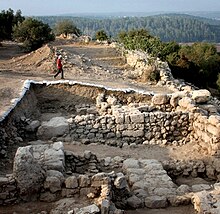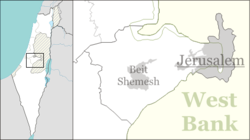
Back خربة قيافة Arabic Churvat Keijafa Czech Khirbet Qeiyafa German Khirbet Qeiyafa French חורבת קייאפה HE Khirbet Qeiyafa ID Хирбет Кейафа Russian 基亞法 Chinese
31°41′47″N 34°57′26″E / 31.69639°N 34.95722°E
 Western gate | |
| Alternative name | Elah fortress |
|---|---|
| Coordinates | 31°41′47″N 34°57′27″E / 31.6963°N 34.9575°E |
| Grid position | 146/122 PAL |
| History | |
| Founded | 10th-century BCE |
| Periods | Iron Age, Hellenistic |
| Site notes | |
| Excavation dates | 2007 – |
| Archaeologists | Yosef Garfinkel, Saar Ganor |
| Condition | ruin |
| Website | qeiyafa |
Khirbet Qeiyafa (Arabic: خِرْبَة قِيَافَة, romanized: Khirbat Qiyāfa), also known as Elah Fortress and in Hebrew as Horbat Qayafa (Hebrew: חוֹרְבָת קַייָאפַה),[1] is the site of an ancient fortress city overlooking the Valley of Elah and dated to the first half of the 10th century BCE.[2][3] The ruins of the fortress were uncovered in 2007,[4] near the Israeli city of Beit Shemesh, 30 km (20 mi) from Jerusalem.[5] It covers nearly 2.3 ha (6 acres) and is encircled by a 700-meter-long (2,300 ft) city wall constructed of field stones, some weighing up to eight tons.[6] Excavations at site continued in subsequent years.[7] A number of archaeologists, mainly the two excavators, Yosef Garfinkel and Saar Ganor, have claimed that it might be one of two biblical cities, either Sha'arayim, whose name they interpret as "Two Gates", because of the two gates discovered on the site, or Neta'im;[8] and that the large structure at the center is an administrative building dating to the reign of King David, where he might have lodged at some point.[9][10] This is based on their conclusions that the site dates to the early Iron IIA, ca. 1025–975 BCE,[11] a range which includes the biblical date for the biblical Kingdom of David. Others suggest it might represent either a North Israelite, Philistine, or Canaanite fortress, a claim rejected by the archaeological team that excavated the site.[12] The team's conclusion that Khirbet Qeiyafa was a fortress of King David has been criticised by some scholars.[11] Garfinkel (2017) changed the chronology of Khirbet Qeiyafa to ca. 1000–975 BCE.[13][14]
- ^ "Khirbet Qeiyafa". National Library of Israel. National Library of Israel.
- ^ Rabinovitch, Ari (30 October 2008). "Archaeologists report finding oldest Hebrew text". Reuters. Retrieved 5 November 2011.
- ^ Na'aman, Nadav (2017). "Was Khirbet Qeiyafa a Judahite City? The Case against It". Journal of Hebrew Scriptures. 17 (7). Edmonton, Alberta: University of Alberta. doi:10.5508/jhs.2017.v17.a7.
- ^ Cite error: The named reference
Vol8Ar22was invoked but never defined (see the help page). - ^ Catling, Chris (6 January 2009). "Elah city-fortress, Khirbet Qeiyafa". Current World Archaeology (33): 8. Archived from the original on 2015-11-26. Retrieved 16 November 2011.
- ^ Garfinkel, Y., S. Ganor, and M.G. Hasel, (2012). "The Iron Age City of Khirbet Qeiyafa after Four Seasons of Excavations", in: The Ancient Near East in the 12th–10th Centuries BCE: Culture and History, p. 153: "The city wall demarcates an area of 2.3 hectares, and its total length is 700m (Figs. 2–3). Due to the local topography, only the external face of the wall is exposed, and the inner part is buried under archaeological remains. The base of the city wall is composed of cyclopean stones, weighing 4–8 tons, while its upper part is built with medium-sized stones."
- ^ Israel Antiquities Authority, Excavators and Excavations Permit for Year 2008, Survey Permit # G-39; Excavators and Excavations Permit for Year 2009, Survey Permit # G-14; Excavators and Excavations Permit for Year 2010, Survey Permit # G-27
- ^ "Khirbet Qeiyafa Identified as Biblical 'Neta'im'". Science Daily. Retrieved 26 March 2011.
- ^ "Have Archaeologists Found King David's Palace?". Bible Gateway. 31 July 2013. Retrieved 1 August 2013.
- ^ "King David's Palace at Khirbet Qeiyafa?". Bible History Daily. Archived from the original on 1 August 2013. Retrieved 1 August 2013.
- ^ a b Finkelstein, Israel; Fantalkin, Alexander (2012). "Khirbet Qeiyafa: An Unsensational Archaeological and Historical Interpretation". Tel Aviv. 39 (1). TEL AVIV, Vol. 39: 38–63. doi:10.1179/033443512x13226621280507. S2CID 161627736. Retrieved 20 July 2017.
We cannot close this article without a comment on the sensational way in which the finds of Khirbet Qeiyafa have been communicated to both the scholarly community and the public. The idea that a single, spectacular finding can reverse the course of modern research and save the literal reading of the biblical text regarding the history of ancient Israel from critical scholarship is an old one. Its roots can be found in W.F. Albright's assault on the Wellhausen School in the early 20th century, an assault that biased archaeological, biblical and historical research for decades. This trend—in different guises—has resurfaced sporadically in recent years, with archaeology serving as a weapon to quell progress in critical scholarship. Khirbet Qeiyafa is the latest case in this genre of craving a cataclysmic defeat of critical modern scholarship by a miraculous archaeological discovery
- ^ Fridman, Julia. Crying King David: Are the ruins found in Israel really his palace? , at Haaretz, 26 August 2013. "Not all agree that the ruins found in Khirbet Qeiyafa are of the biblical town Shaarayim, let alone the palace of ancient Israel's most famous king."
- ^ Garfinkel, Yosef, (2017). "The Iron Age City of Khirbet Qeiyafa", in: The Shephelah during the Iron Age, Penn State University Press, p. 115: "Initially, only a few dates were published, but we now have 27 measurements, all made on short-lived samples (mainly olive pits) deriving from a single occupation layer that existed for 20 or 30 years at most. Khirbet Qeiyafa was built around 1000 BCE and was destroyed around 980 or 970 BCE (Garfinkel et al. 2012; Garfinkel et al. 2015)."
- ^ Garfinkel, Yosef, (2023). "Early City Planning in the Kingdom of Judah: Khirbet Qeiyafa, Beth Shemesh 4, Tell en-Naṣbeh, Khirbet ed-Dawwara, and Lachish V", in: Jerusalem Journal of Archaeology, Volume 4, The Hebrew University of Jerusalem, p. 89: "Carbon-14 dates assign the fortified city to the first quarter of the 10th century BCE [...]"
